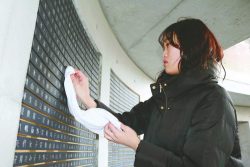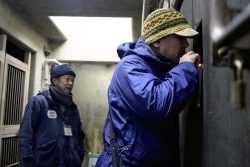16:15 JST, December 21, 2023
Children’s eyesight continues to worsen. The widespread use of digital devices is thought to be a major factor in this ocular decline. The government must take preventive measures nationwide.
According to a school health statistics survey for the 2022 school year released by the Education, Culture, Sports, Science and Technology Ministry, the percentage of children with visual acuity of less than 1.0 on the Japanese acuity scale — equivalent to 20/20 vision — increased to a record high of 38% at elementary schools, 61% at junior high schools and 72% at high schools, marking a 20 percentage point rise from more than 40 years ago for all categories.
This is due to kids’ increased interactions with video game consoles and smartphones, according to the survey. It is commonly held that myopia makes daily life inconvenient and increases the risk of developing cataracts, retinal detachment and other diseases.
Some children develop acute esotropia, a condition in which the eye turns inward due to continuously looking at the small screens of smartphones. The increase in nearsighted children reportedly has made it more difficult for schools to place them in classroom front rows so they can see the blackboard more easily whenever seats are reallocated.
Measures must be urgently implemented to prevent a further increase in the number of children with poor eyesight.
When using digital devices at school or home, it is necessary to try to use them in well-lit locations, with devices held at least 30 centimeters from users’ eyes.
It is also important for children to rest their eyes regularly and sometimes spend more time away from digital devices, such as by playing outside and looking at greenery.
Recent studies have shown that two hours daily of moderate exposure to sunlight can help prevent eyesight from declining. In Taiwan, outdoor activities were reportedly promoted at elementary schools, with students’ eyesight improving as a result.
Childhood measures are essential to prevent kids from losing visual power. Hopefully, the central and local governments will work closely with experts to develop preventative plans that can be implemented at schools and other locations.
In Obu, Aichi Prefecture, visiting lectures on eye health were held for elementary school students in cooperation with a university and companies. To make the lessons enjoyable, a calendar was distributed to each child, who was tasked with placing stickers on days when they achieved eye-healthy behavior goals.
The central government must strive to investigate similar domestic and overseas efforts and disseminate such information so that these initiatives can easily be used as a reference in various places.
It is also vital to be aware of eyesight decline at an early stage. Although it is difficult to cure myopia, it is possible to reduce its progression by making changes to one’s lifestyle, among other measures.
Many children do not receive medical examinations, even when their school health checkups show that they need to be reexamined. According to a survey by Hodanren, the Japanese Medical and Dental Practitioners for the Improvement of Medical Care, half of such children did not receive medical examinations. Schools and local governments should make efforts to enlighten parents and guardians about the significance of medical examinations.
It is said that people receive about 80% of information from their visual sense. Efforts should therefore be made to promote understanding of the importance of eye health.
(From The Yomiuri Shimbun, Dec. 21, 2023)
"Editorial & Columns" POPULAR ARTICLE
-

Artificial Intelligence Expands Possibilities for Foreign Language Learners
-

Build Intellectual, Physical Strength, As Well As Communicative Power / Japan Should Move from Beneficiary to Shaper of World Order
-

Global Economy in Turmoil: Prevent Free Trade System from Going Adrift / Risks to Financial Markets Must Be Heeded
-

Japan-China Strain Set to Persist as Beijing Officials Self-Interestedly Bash Tokyo; Takaichi Unlikely to Back Down
-

French and German Ambassadors to Japan Call for Democracies to Unite in Defense against Russian Disinformation
JN ACCESS RANKING
-

As Chinese Tourists Shun Japan, Hotels and Stores Suffer
-

Core Inflation in Tokyo Slows in December but Stays above BOJ Target
-

BOJ Gov. Ueda: Highly Likely Mechanism for Rising Wages, Prices Will Be Maintained
-

Osaka-Kansai Expo’s Economic Impact Estimated at ¥3.6 Trillion, Takes Actual Visitor Numbers into Account
-

Japan Govt Adopts Measures to Curb Mega Solar Power Plant Projects Amid Environmental Concerns






















